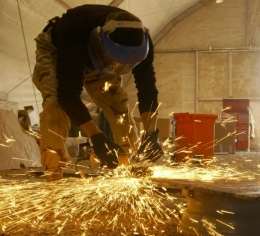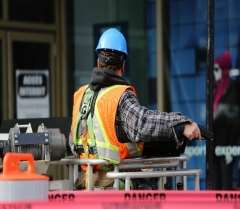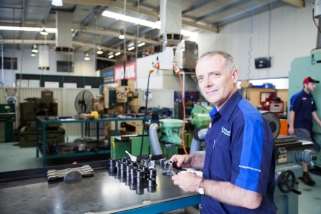Healthy and Safety Review of Business
|
WORKPLACE HEALTH AND SAFETY |
|
|
|
|
|
BOLT AND CATCH PTY LTD AUDIT AND REVIEW |
|
|
An in-depth review of work health and safety from within the Bolt And Catch Pty Ltd business. This report will additionally include a formal WHS audit and recommendations for improvements to various workplace health and safety aspects of the company. Reported conducted and written by Edin Jusupovic. |
Scope of Report
Report Objectives
The objectives will be listed below for this report.
- Identify Workplace Health and Safety legal requirements for Bolt and Catch.
- Identify all potential hazards in the B & C risk register.
- Identify potential hazards, assess any associated risk and, in turn, develop appropriate controls for the identified risks – additionally record any responsibilities and set key performance indicators in the form of completion dates for any actions that are to be taken.
- Develop a draft procedure for identifying hazards, hazard assessment procedures and controlling any associated risks.
- Provide recommendations for ensuring continual compliance with any relevant legislations for workplace health and safety.
- Conduct an audit of the workplace that will later be used to achieve the outlined report objectives.
Parameters
The parameters, otherwise known as limitations or “scope” of this report will be outlined below.

- Limited to the results obtained through the audit of the report.
- Parameters limited to the Bolt and Catch business only.
Constraints
Any applicable constraints to the report will be listed below.
- Any research must be using appropriate legislations that are applicable Australia wide or local (applicable to NSW) and as such, must not use other any other states workplace health and safety laws or legislations for the purpose of this report.
COMPANY BACKGROUND
Bolt and Catch is an ASIC registered proprietary limited company located in Australia, New South Wales. The company is a large manufacturer of gate bolts and hinges with a long reputable history of well over seventy years in the industry.
The company provides a variety of manufacturing products tailored for both commercial and agricultural use.
STAFF
Bolt and Catch currently employs 120 people spanning a large variety of company areas. These staff departments include areas such as;
- Human Resources
- Marketing and Sales
- Engineering
- Trade and Production Personnel.
AREA OF WORK
Bolt and Catch has a primary area of work in manufacturing gate bolts and hinges. These manufactured goods are then deployed by other businesses for a variety of purposes such as commercial and agricultural use.
The company engages in both manufacturing and marketing of the products, alongside sales; this is made possible through dedicated departments within the business.
The B&C risk register can be seen in Appendix A. This register was obtained through Safe Work Australia – Code of practice for management of work health and safety risks, 2011 edition.
The B&C risk register has several functional components;
- Hazard
- Harm as a result of identified hazard
- Likelihood of hazard occurring
- Level of risk
- Effectiveness of current controls
- Further control requirements and suggestions
- Control implementation information
The following may be used in the risk register as identifiers;
Level of Risk Scoring
|
CRITICAL |
A |
|
HIGH |
B |
|
MEDIUM |
C |
|
LOW |
D |
Likelihood Scoring
|
HIGH |
A |
|
MEDIUM |
B |
|
INTERMEDIATE |
C |
|
LOW |
D |
The B&C risk register is an important audit tool for reviewing the workplace health and safety at Bolt and Catch Pty Ltd.
Purpose
The purpose of this document is to create a procedural system for ensuring hazards are identified, assessed based on risk and are controlled to provide effective safety management in the Bolt and Catch workplace.
Introduction

Through New South Wales workplace health and safety legislation, we identify a PCBU, or otherwise known as a Person Conducting A Business or Undertaking with certain core safety responsibilities under the Work Health and Safety act of 2011. This legislation states that a PCBU must manage risks to health and safety as far as is reasonably practicable. A risk management system involves considering the careful identification of applicable hazards and providing assessment of these risks and hazards followed by the expulsion and removal of any risks in the first occurrence, or, if this is not possible – reducing these risks as far as is reasonably practicable.
The risk management system is highly recommended for the following reasons;
- It is an extremely feasible and easily applicable approach and system.
- Cost effective when compared to similar management systems.
- Provides a wide range of support for all associated parties including – workers, contractors, visitors and any other people associated with Bolt and Catch.
- Allows Bolt and Catch Pty Ltd to provide the required level of duty of care to all staff, customers and contractors and, so that the company may meet all necessary legislations pertaining to health and safety.
Workplace health and safety hazard identification, assessment and potential control is a continuous process that must be executed throughout various periods and situations, these can include;
- When new data is made available about a risk and/or if issues or concerns are raised about any existing risk.
- Continuous improvement by ensuring regular reviews at appropriate times in the workplace.
- The process should be undertaken if it has not been conducted before.
- The process should be conducted if a hazard has been identified.
- Undertaken as part of responding to an incident, regardless of whether an injury has or has not occurred.
- The process should be executed when any changes are introduced and/or any changes that may affect a hazard or cause a potential new hazard. The scope of this can include any changes in the workplace, equipment, procedures, general environment or practices.
The procedure outlined below is designed to be an easily applied guide to assist in ensuring the safety for workers, contractors, visitors and any applicable associated parties with Bolts and Catch Pty Ltd. The policy will assist both workers and management, through careful consulting, to comply with workplace health and safety legislation. Recording and bookkeeping of any risk management activities, such as risk assessments and consultation processes will be required.
This process will assist in;
- Discovering any potential new hazards in the workplace.
- Monitoring, auditing and reviewing the effectiveness of any applied control measures.
- Setting and determining control measures in order to expel or minimize the magnitude of any risks in the workplace.
- Conducting assessments to assess the risks that may potentially result from hazards.
Definitions
This section will provide clarification for any definitions in the policy.
PCBU: A ‘person conducting a business or undertaking’ (PCBU) is a legal term under WHS laws for individuals, businesses or organizations that are conducting business. A person who performs work for a PCBU is considered a worker.
Risk: A situation involving exposure to danger.
Risk control: Risk control is the method by which firms evaluate potential losses and take action to reduce or eliminate such threats.
Risk assessment: a systematic process of evaluating the potential risks that may be involved in a projected activity or undertaking.
Hazard: A danger or risk.
Hazard identification: Hazard identification is a process used to identify possible situations where people may be exposed to injury, illness or disease, the type of injury or illness that may result from these and the way in which work is organized and managed.
WHS: Occupational safety and health (OSH), also commonly referred to as occupational health and safety (OHS), occupational health, or workplace health and safety (WHS), is a multidisciplinary field concerned with the safety, health, and welfare of people at work.
Monitor and review: Monitoring and reviewing is a planned part of the risk management process and involves regular checking or surveillance. The results should be recorded and reported externally and internally, as appropriate. The results should also be an input to the review and continuous improvement of the firm’s risk management framework.
ACCOUNTABILITY
Ensuring the efficient and effective management of risk requires continual commitment to the process and system from all managers and officers, including any input and involvement of workers or applicable staff.
The responsibility of workplace health and safety additionally extends to all management and supervisory staff – the scope of their role in WHS is to ensure that this policy, in its entirety, is completely implemented in their areas of potential control and, to consult where possible with workers, contractors and any other applicable staff as part of undertaking the hazard identification, risk assessment and control process outlined in this policy.
A key accountability area in any WHS policy are officers; whom have a direct responsibility of safeguarding and ensuring that their area or areas of control are completely compliant with all relevant legislative requirements.
Risk Assessment Procedure
The bibliography section of this report will provide any references to links, images or resources that have been utilized in production of this WHS report.
This page has been left blank
Appendix A
|
Location: |
Date: |
|||||||
|
Hazard |
What is the harm that the hazard could cause? |
What is the likelihood that the harm would occur? |
What is the level of risk? |
How effective are the current controls? |
What further controls are required? |
How will the controls be implemented? |
||
|
Action by |
Due Date |
When Completed |
||||||
|
Some staff in the press room are failing to wear protective equipment. |
|
B |
B |
Current controls are intermediate however, not enforced. |
|
05/01/2017 |
10/01/2017 |
|
|
No protective equipment around the three new Chinese press machines. |
|
A |
A |
Current controls are poor as the machines lack protection. |
|
05/01/2017 |
08/01/2017 |
|
|
Noise pollution in progress room, staff shouting to communicate. |
|
C |
C |
Current controls are very poorly effective. |
|
05/01/2017 |
10/01/2017 |
|
|
New Chinese presses do not have adequate safety features – no head guarding around stamp press. |
|
C |
A |
Current controls are extremely poor and nonexistent. |
|
05/01/2017 |
07/01/2017 |
|
|
Imported Chinese presses do not have English instructions and have text translated by an employee. |
|
B |
B |
Current controls are intermediately effective. |
|
05/01/2017 |
08/01/2017 |
|
|
Sign placement is incorrect – start, jog and stop buttons placed out of sight and directly above operator’s head, outside line of sight. |
|
A |
B |
Current controls in their current state are poor. |
|
05/01/2017 |
10/01/2017 |
|
|
Fork lift drivers in carpark. |
|
B |
C |
The current controls in place are not existent and poor. |
|
05/01/2017 |
09/01/2017 |
|

